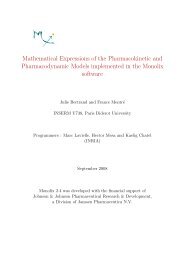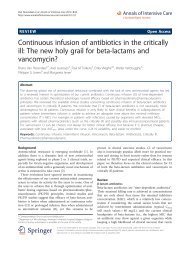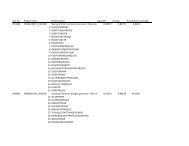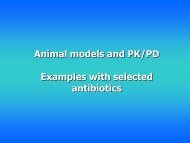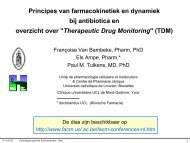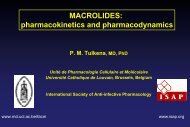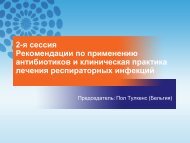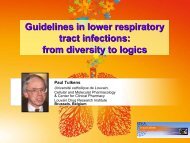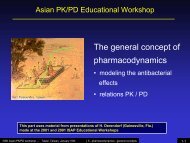3C-Pharmacodynamics: actual data - UCL
3C-Pharmacodynamics: actual data - UCL
3C-Pharmacodynamics: actual data - UCL
You also want an ePaper? Increase the reach of your titles
YUMPU automatically turns print PDFs into web optimized ePapers that Google loves.
<strong>Pharmacodynamics</strong>: <strong>actual</strong> <strong>data</strong>How shall we dosetime-dependentconcentration-dependentantibiotics ?With the support of Wallonie-Bruxelles-International<strong>UCL</strong> PK/PD Course April 2011<strong>3C</strong>-1
from pharmacokinetics to pharmacodynamics...0.4Pharmacokineticsconc. vs time<strong>Pharmacodynamics</strong>conc. vs effectConc.Effect0.00 25TimeConc. (log)10-3Effect1PK/PDeffect vs time00Time<strong>UCL</strong> PK/PD Course April 2011<strong>3C</strong>-2
from pharmacokinetics to pharmacodynamics...ConcentrationC maxAUC > MICCmax / MICAUC / MICTime ~ conc > MICMICt > MIC0 6 12 18 24Time (h)<strong>UCL</strong> PK/PD Course April 2011<strong>3C</strong>-3
Main PK/PD properties of antibioticsAvailable antibiotics can be divided in 3 groups :• time - dependent (T > MIC)• AUC / MIC - dependent• both AUC / MIC and peak / MIC -dependent<strong>UCL</strong> PK/PD Course April 2011<strong>3C</strong>-4
Antibiotics Group # 1(after W.A. Craig, 2000; revised 2002 and 2003)1. Antibiotics with time-dependent effectsand no or little persistent effectsAB-lactamsPK/PD parameterTimeaboveMICGoalMaximizethe exposuretime<strong>UCL</strong> PK/PD Course April 2011<strong>3C</strong>-5
How long should you stay above the MIC ?40 %Moderate infections• cefotaxime• neutropenic mice• K. pneumoniae• lung infectionSerious infections100 %<strong>UCL</strong> PK/PD Course April 2011<strong>3C</strong>-6
More experimental <strong>data</strong>with penicillins, cephalosporins and carbapenems ...different pathogens• same shape ofdose response• diff. in T > MICfor a static effect(penicill. > carbap.)• diff E max(penicill. < carbap.)Andes & Craig Int. J. Antimicrob. Agents 2002, 19: 261-268<strong>UCL</strong> PK/PD Course April 2011<strong>3C</strong>-7
1. Increase the unitary dosis ?How to optimize T > MIC ?ConcentrationMICdosis = 1Time (h)<strong>UCL</strong> PK/PD Course April 2011<strong>3C</strong>-8
1. Increase the unitary dosis ?How to optimize T > MIC ?Concentrationdosis = 2But useless peak !!MICdosis = 1Time (h)gain...<strong>UCL</strong> PK/PD Course April 2011<strong>3C</strong>-9
How to optimize T > MIC ?2. Increase the number of administrations ?ConcentrationSeems more logical …MICTime (h)<strong>UCL</strong> PK/PD Course April 2011<strong>3C</strong>-10
-lactams : applications...• Respiratory tract infections (oral route)…• Serious infections (intravenous route)<strong>UCL</strong> PK/PD Course April 2011<strong>3C</strong>-11
Optimizing dosage for amoxycillinoral amoxycillin (MIC = 1 mg/l)T > MIC (%)100806040204X/day3X/day2X/day1X/dayT > MIC40 - 60 %00 500 1000 1500 2000individual dosis<strong>UCL</strong> PK/PD Course April 2011<strong>3C</strong>-12
Optimizing dosage for amoxycillinoral amoxycillin (MIC = 1 mg/l)T > MIC (%)100806040204X/day3X/day2X/day1X/dayT > MIC40 - 60 %00 500 1000 1500 2000Appropriate dose =500 mg 3-4 X/d or 1000 mg 2 X/dindividual dosis<strong>UCL</strong> PK/PD Course April 2011<strong>3C</strong>-13
Optimizing dosage for cefuroximeoral cefuroxime (MIC = 1 mg/l)100804X/day3X/dayT > MIC (%)6040202X/dayT > MIC40 - 60 %01X/day0 125 250 375 500individual dosis<strong>UCL</strong> PK/PD Course April 2011<strong>3C</strong>-14
Optimizing dosage for cefuroximeT > MIC (%)100806040200oral cefuroxime (MIC = 1 mg/l)4X/day3X/day2X/day1X/day0 125 250 375 500Appropriate dose =125 mg 4 X/d or 250 mg 3 X/d or 500 mg 2 X/dindividual dosisT > MIC40 - 60 %<strong>UCL</strong> PK/PD Course April 2011<strong>3C</strong>-15
Oral - lactams and S. pneumoniaeAn MIC of 2 µg/ml is the limit that you can coverin optimal conditions, i.e. with a 3 x / dayadministration and a total daily dosis of 3 g for amoxicillin 1-1.5 g for cefuroxime-axetilPK/PD breakpoint for oral - lactams:MIC < 2 µg/ml<strong>UCL</strong> PK/PD Course April 2011<strong>3C</strong>-16
-lactams : applications...• Respiratory tract infections (oral route)…• Serious infections (intravenous route)<strong>UCL</strong> PK/PD Course April 2011<strong>3C</strong>-17
Typical pharmacokinetics of an IV -lactamtimeserum concentration for(hours) 0.5 g 1 g 2 g2 25 50 1004 12.5 25 506 6 12 258 3 6 1210 1.5 3 612 0.75 1.5 3* Single administration unique; half-life 2h ; V d= 0.2 l/kg<strong>UCL</strong> PK/PD Course April 2011<strong>3C</strong>-18
Typical pharmacokinetics of an IV -lactamtimeserum concentration for(hours) 0.5 g 1 g 2 g2 25 Where would 50 you 100 like to be ?4 12.5 25 506 6 12 258 3 6 1210 1.5 3 612 0.75 1.5 3* Single administration unique; half-life 2h ; V d= 0.2 l/kg<strong>UCL</strong> PK/PD Course April 2011<strong>3C</strong>-19
Optimisation of IV -lactamsfor "difficult" organisms• 2 g every 12 h T > MIC = 100 %if MIC 3 mg/L !• 2 g every 8 h T > MIC = 100 %if MIC 12 mg/LMore frequent administrations is the best way toincrease the activity of -lactams in difficult-to-treatinfections...PK / PD breakpoint forIV -lactams : MIC < 8 µg/ml<strong>UCL</strong> PK/PD Course April 2011<strong>3C</strong>-20
3. Continuous infusionCan we do still better ?ConcentrationConcentration always above the MIC !MICTime (h)<strong>UCL</strong> PK/PD Course April 2011<strong>3C</strong>-21
Yes :Continuous infusion: the solution ?• Optimized mode of administration• Possibility to obtained stable concentrations as high as20 to 40 mg/LBut be careful …• To the stability of the molecule– the -lactam ring is intrinsically breakable … temperature !!!• To incompatibilities with other molecules alsoadministered by continuous infuisonCaution rules need to be respected ….<strong>UCL</strong> PK/PD Course April 2011<strong>3C</strong>-22
Yes :Continuous infusion: the solution ?• Optimized mode of administration• Possibility to obtained stable concentrations as high as20 to 40 mg/LThere will be a special course on-lactams by continuous infusion !!But be careful …• To the stability of the molecule– the -lactam ring is intrinsically breakable … temperature !!!• To incompatibilities with other molecules alsoadministered by continuous infuisonCaution rules need to be respected ….<strong>UCL</strong> PK/PD Course April 2011<strong>3C</strong>-23
Antibiotics Group # 2(after W.A. Craig, 2000; revised 2002 and 2003)2. Antibiotics with time-dependent effects,no or little influence of concentration,but marked persistent effectsABglycopeptidestetracyclinesmacrolidesstreptograminsoxazolidinonesPK/PD parameterAUC / MICGoaloptimizethe amount ofantibiotic<strong>UCL</strong> PK/PD Course April 2011<strong>3C</strong>-24
Antibiotics Group # 3(after W.A. Craig, 2000; revised 2002 and 2003)3. Antibiotics with concentration-dependentbactericidal activity and prolonged persistenteffects (post-antibiotic effects)ABaminoglycosidesfluoroquinolonesdaptomycinPK/PD parameterPeak andAUC / MICGoaloptimize thepeak andthe amount ofantibiotic<strong>UCL</strong> PK/PD Course April 2011<strong>3C</strong>-25
Aminoglycosides: get a peak !<strong>UCL</strong> PK/PD Course April 2011<strong>3C</strong>-26
Aminoglycosides: get a peak !Peak/MIC > 81. Appropriate mode ofadministrationIV route2. Calculation of the necessarypeak valueminimal peak: = MIC x 83. Calculation of the adequate dosispeak = dosis / Vddosis = peak x Vddosis = MIC x 8 x Vd<strong>UCL</strong> PK/PD Course April 2011<strong>3C</strong>-27
Aminoglycosides: get a peak !243 mg / kg - 1 X day20concentration (mg/l)16128400 4 8 12 16 20 24time (h)MIC = 2 peak/MIC ~ 6MIC = 0.5 peak/MIC ~ 24* aminoglycoside with half-life= 1 h and V d = 0.25 l/kg<strong>UCL</strong> PK/PD Course April 2011<strong>3C</strong>-28
Aminoglycosides: get a peak !Increase the dose!246 mg / kg - 1 X jour20concentration (mg/l)16128400 4 8 12 16 20 24time (h)MIC = 2 peak/MIC ~ 12MIC = 0.5 peak/MIC ~ 48* aminoglycoside with half-life= 1 h and V d = 0.25 l/kg<strong>UCL</strong> PK/PD Course April 2011<strong>3C</strong>-29
Aminoglycosides: which dosis for which MIC ?peak/MICdosis peak (mg/L) if MIC =(mg/kg) for V d = 0.25 l/kg 4 2 1 0.51 4 1 2 4 82 8 2 4 8 163 12 3 6 12 244 16 4 8 16 326 24 6 12 24 488 32 8 16 32 64<strong>UCL</strong> PK/PD Course April 2011<strong>3C</strong>-30
Aminoglycosides: which dosis for which MIC ?peak/MICdosis peak (mg/L) if MIC =(mg/kg) for V d = 0.25 l/kg 4 2 1 0.5There will be a special course on1 4 1 2 4 82aminoglycosides 8 dose optimization 2 4 8 ! 163 12 3 6 12 244 16 4 8 16 326 24 6 12 24 488 32 8 16 32 64<strong>UCL</strong> PK/PD Course April 2011<strong>3C</strong>-31
Optimization of aminoglycoside usagedo not try to treat with aminoglycosides bacteria with MIC• > 2 µg/ml for molecules with maximal daily dosis of 6 mg/kg• > 4 µg/ml for molecules with maximal daily dosis of 15 mg/kgPK / PD breakpoints for AG• Genta, Netil, Tobra : 2 µg / ml• Amika / Isépa : 4 µg / ml<strong>UCL</strong> PK/PD Course April 2011<strong>3C</strong>-32
Fluoroquinolones: get a peak and an AUC !increase the amount administered,in order to optimize AUC/MICConcentrationMICPeak/MICand peak/MICAUC/MICshould be > 125should be > 10Get both a peak and a AUC !!Time (h)MIC <strong>data</strong>: J. Verhaegen et al., 2001<strong>UCL</strong> PK/PD Course April 2011<strong>3C</strong>-33
How to optimize the AUC / CMI ratio ?AUC = dosis / ClAdjust the daily dosis~ target AUCAdapt the number of administrations~ pharmacokinetics of the drug<strong>UCL</strong> PK/PD Course April 2011<strong>3C</strong>-34
AUC and peak after one dose are directly relatedto this dose10a “theoretical” example...Concentration3 5 2.51 gAUC= 2410.5 gAUC= 12.3 1.5 0.750Time (hours)6<strong>UCL</strong> PK/PD Course April 2011<strong>3C</strong>-35
24h-AUC is inversely related to the drug clearance(BUT so is NOT the peak …)101ga “theoretical” example... 5Concentration31t½ 1 ht½ 0.5 ht½ 2 hAUC= 48AUC= 24.3AUC= 120Time (hours)6<strong>UCL</strong> PK/PD Course April 2011<strong>3C</strong>-36
24h-AUC is correlated to the number of unit doses(BUT, again, so is NOT the peak …)10 5a “theoretical” example...Concentration1g2 x 1g31AUC= 48.3AUC= 240Time (hours)12<strong>UCL</strong> PK/PD Course April 2011<strong>3C</strong>-37
PK/PD of fluoroquinolones in a nutshellRemember:• 24h-AUC is proportional to the daily dose• peak is proportional to the unit dose...• get a 24h-AUC /MIC > 125, and• get a peak / MIC ratio > 8efficacy• get this with the total daily doseand the appropriate unit dose …<strong>UCL</strong> PK/PD Course April 2011<strong>3C</strong>-38
AUC / MIC = 125 : a magic number ?Patients respond to quinolonesas a function of the 24 h-AUC ofthe quinolone they receive andthe MIC of the offendingorganism(example for Gram - infectionsseen in the "Methods")Forrest et al (1993) AAC 37:1073-81.<strong>UCL</strong> PK/PD Course April 2011<strong>3C</strong>-39
But remember that, for Gram (+),the immune status is critical ... (as seen in the methods)Relationship Between 24 Hr AUC/MIC and Mortalityfor Fluoroquinolones against S. pneumoniae in Immunocompetent vs.Immunocompromised animal ModelsPercent mortality100806040200Emax at30 ...Percent mortality100806040200Emax at125 ...1 2.5 5 10 25 50 10024 Hr AUC/MICnon-neutropenic3 10 30 100 300 100024 hr AUC/MICneutropenicAdapted from W.A. Craig : 7th ISAP Educational Workshop, San Diego, CA, 2002<strong>UCL</strong> PK/PD Course April 2011<strong>3C</strong>-40
Defining PK/PD breakpoints for fluoroquinolonesPK/PD Bkpts (mg/L)Drug Dosage AUC/MIC peak / MIC(mg/24h) (24h)norfloxacin 800 0.1 0.2ciprofloxacin 500 0.1 0.2ofloxacin 400 0.2-0.4 0.3 - 0.4levofloxacin 500 0.4 0.4 - 0.5moxifloxacin 400 0.4 0.4<strong>UCL</strong> PK/PD Course April 2011<strong>3C</strong>-41
Adjust the dosis to the MICDaily dosage of AUC * MIC for anlevofloxacin AUC 24h /MIC = 125250 28 0.2500 56 0.41000 112 0.8* based on normal half-lifes;CL ~ 100 mg/dldoses for an adult of 65 kg<strong>UCL</strong> PK/PD Course April 2011<strong>3C</strong>-42
But keep the unitary dose in the allowed limit …!Peak -related side effects :SNC toxicityInhibition of CYP 450 activitychondrotoxicityphototoxicity<strong>UCL</strong> PK/PD Course April 2011<strong>3C</strong>-43
Choose the most active moleculedrug Dosage AUC * MIC for MIC(mg/24h) AUC/MIC = 125 S. pneumoofloxacin 400 66 0.5 2levofloxacin 500 73 0.4 1ciprofloxacin 1000 40 0.3 0.5-2moxifloxacin 400 48 0.4 0.01-0.5<strong>UCL</strong> PK/PD Course April 2011<strong>3C</strong>-44
PK/PD: take home message1. For each drug, choose on a PK/PD basis the appropriate• scheme of administration• daily dosis2. Adapt the dosage to the susceptibility of the target organism,• based on MIC <strong>data</strong> for the individual patient• based on local epidemiology<strong>UCL</strong> PK/PD Course April 2011<strong>3C</strong>-45
PK/PD : from today to tomorrowtoday : applying these conceptscan help us to reachan optimized efficacybut let's prepare tomorrow:how can we use this scienceto avoid resistance development ?Section 4 A<strong>UCL</strong> PK/PD Course April 2011<strong>3C</strong>-46



